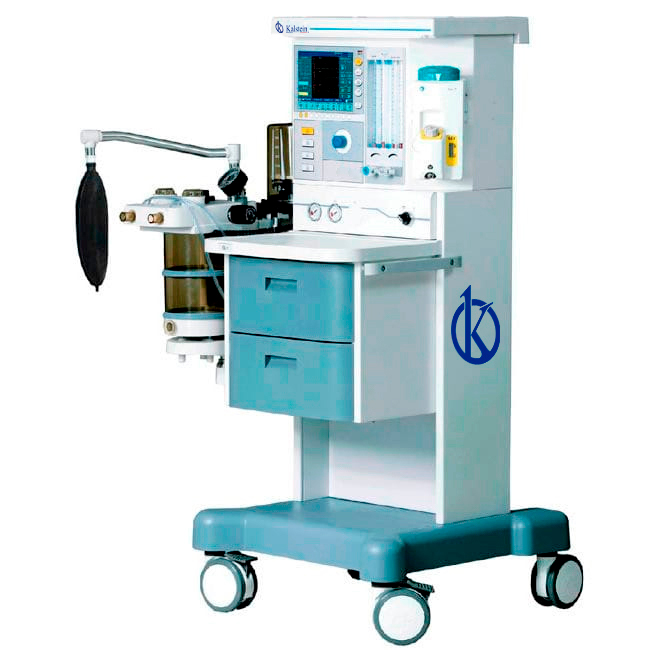The anesthesia machine is a computer capable of introducing patients to anesthetic drugs that cause sedation and allow to control their respiratory function. These equipment allow to monitor the temperature, EEG, neuromuscular transmission, monitor the different changes in the respiration and to control the depth, among others.
It should be noted that the teams are handled by anesthesiologists, entities authorized to administer drugs by different routes in the human body, to bring it to a state where surgery can be performed. Thus, they are determined by a delicate balance between observation and supervision of body functions, and in turn react quickly to a life-threatening situation, which, if not recognized early, is properly diagnosed and treated accordingly, could yield irreversible reactions in patients.
Anesthesia Machine Control Systems
Depending on the degree of modernity of the anesthesia machines, they are represented as follows:
- High Pressure System: Focused on 3 important factors that are, a backup gas source, safety devices, and a clinical gas source.
- Low Pressure System: It is associated in 4 factors, an antireflux valve, valves to control the flow, vaporizers and a rapid flow valve.
- Circular System: Consisting of 7 different factors, a soda lime socket, a Y-connector, expiratory and inspiratory preloaded tubes, unidirectional valves, an APL overpressure valve, a bag, a ventilator and a gas inlet.
Expected Interest and Benefits by Using Anesthesia Machines
The person in charge of working and controlling the anesthetic machine, consists of supplying a drug, observing its effect, and seeing the drug exchange – Inhalation and to adapt the pharmacological requirements to the patient’s characteristics and to the properties of the administered drug. Although at a higher level of monitoring their effect is closely monitored, depending on the dose they could be even lethal, therefore appropriate supportive measures are adopted. The anesthetic environment – Inhalation Surgical, it is extremely dynamic and can change circumstances very quickly.
Thus, overall the expected benefits are
- To certify the accuracy in the dose of the anesthetic agent to adjust the requirements of the patients and avoid the problems derived from the different levels of surgical stimulation.
- To optimize the efficiency of medical care and surgical procedures by increasing the safety of administering anesthetic drugs during surgical procedures, avoiding underdosing.
The function and proper control of anesthesia machines determines the appropriate infusion rate to achieve the desired drug concentration level in the patient. In reality, the anesthesiologist frequently adjusts the target chosen according to the patient’s needs, the progress of surgery, and other factors, such as the degree of neuromuscular blockade or the need for analgesics.
Monitoring by using the Anesthesia Machine
Monitoring the patient involves recognizing not only the variables that require attention from the point of view of anesthesia, but also explaining the data provided by the system and deciding when to deviate from the limits accepted as normal, in order to take an appropriate decision to cancel negative effects for the patient and evaluate the effectiveness of the action taken. Technological advances have provided the surveillance work of the anesthesiologist, becoming an adjunct to his clinical judgment.
Thus, basic, noninvasive monitoring in anesthesia examines key parameters in vital systems that can be damaged by lack of oxygen or by lack of blood circulation (heart, brain, kidneys), ECG (electrocardiogram), SpO2 (pulse oximetry), PANI (noninvasive blood pressure), and temperature.
Extended monitoring also records invasive blood pressure, neuromuscular relaxation, central venous pressure, intracranial pressure.
For some, this contrast between the steady state of anesthesia with stable body functions and rapidly occurring emergencies represents the challenge and fascination of this specialty. For others, it is a constant source of tension. It is not surprising that anesthesia is one of the specialties with the highest number of parameters to be monitored continuously, and if necessary, corrected.
Anesthesia machines in Kalstein
We at Kalstein, offer you the anesthesia machine that will facilitate the role of the physician in charge and you can start with a routine application according to the needs of the patient. The anesthesia machine, can be upgraded to better meet the anesthetic requirements of customers. The expansion of the modern anesthesia workstation, is also feasible to greatly improve the workflow and reduce operating costs. In addition, it offers electronic PEEP function. It provides a high accuracy output of only 20 ml. It uses latex-free and self-claving components. It can be easily maintained and cleaned without specialized tools. It is CE certified, providing peace of mind for users.
We are manufacturers and we have the best advice to make your purchase the ideal one, with excellent prices. For a better experience, visit our catalog HERE
Learn about our products at HERE

